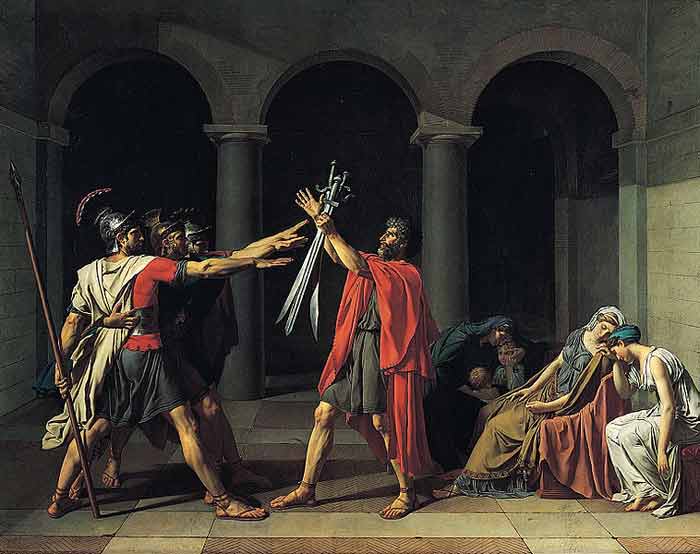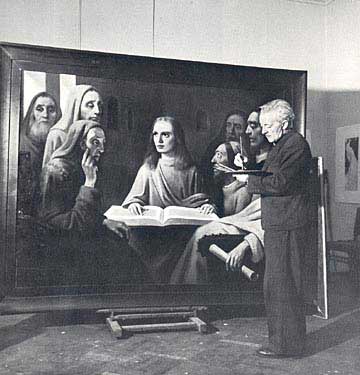On 31 Oct, 2010 With
Information art Information art (or ‘informatism’ ) is an emerging field of electronic art that synthesizes computer science, information technology, and more classical forms of art, including performance art, visual art, new media art and conceptual art. Information Art often includes interaction with computers that generate artistic content based on the processing of large amounts of data. Informatism follows on the 1970 exhibition organized by Kynaston McShine called “Information”, held at the Museum of Modern Art in New York City – a show that formally established conceptual art as a leading tendency in the United States. This tendency then spread widely throughout the world. Thisconceptual trend followed on the activities of Experiments in Art and Technology known as E.A.T. Artistic practice Information art data can be manifested using photographs, census data, micropayments, personal profiles and…
Read More
On 30 Oct, 2010 With
Neo-figurative art describes an expressionist revival in modern form of figurative art. The term neo and figurative emerged in the 1960s in Mexicoand Spain to represent a new form of figurative art. Neo-figurative artists Famous Neo-figurative artists include: Fernando Botero Grupo Hondo (Spain) Antonio Berni Veronica Ruiz de Velasco Oswaldo Viteri
Read More
On 29 Oct, 2010 With
Massurrealism Massurrealism is the name given to an art genre characterized by the convergence of surrealism and mass media, including the influence of pop art. The definition was originated in 1992 by American artist, James Seehafer. History Massurrealism is a development of surrealism that emphasizes the effect of technology and mass media on contemporary surrealist imagery. James Seehafer who is credited with coining the term in 1992 said that he was prompted to do so because he had been unable to find a simple explanation to characterise the type of work he was doing, which combined elements of surrealism and mass media, the latter consisting of technology and pop art—”a form of technology art.” He had begun his work by using a shopping cart, which “represented American…
Read More
On 28 Oct, 2010 With
The number of visitors, 3.000 people, who have visited Palazzo Cini and seen Kitsch Biennale 2010 during the first 20 days bear witness of the public appreciation and its success. The Kitsch Biennale is an international exhibition for figurative and narrative painting. This year, the jury consisted of Bjørn Li (The Nerdrum Institute) and the kitsch painters Odd Nerdrum, Helene Knoop, Jan-Ove Tuv and David Dalla Venezia. They have focused on applicants displaying the serious and earnest expression. This sets the exhibition concept apart from the general trend of contemporary figurative painting. Works with an eternal outlook have been preferred.
Read More
On 28 Oct, 2010 With
Read More
On 27 Oct, 2010 With
Marie-Thérèse Walter and Picasso (1927-1936) n 1927 Picasso met Marie-Thérèse Walter (1909-1977), a 17 year old who Picasso then lived with in a flat across the street from his marital home (while still married to Olga). Marie-Thérèse and Picasso had a daughter, Maya (Maria de la Concepcion) on October 5, 1935. (Picasso and Olga later separated although they remained married so Olga would not receive half of Picasso’s wealth — until she died in 1955. ) Picasso’s relation with Marie was kept from Olga until Olga was told of Marie’s pregnancy. Marie understandably became jealous when Picasso started to fall in love with Dora Maar in 1936, a year after Maya was born. It was Marie-Thérèse who was the inspiration for many of Picasso’s famous Vollard Suite etchings. …
Read More
On 27 Oct, 2010 With
A rare self portrait by Edouard Manet’s has sold for more than £22 million at auction, in a record sale for the artist By Andrew Hough The painting, “Self Portrait with a Palette”, was bought for a record price by New York dealer Franck Giraud, who was bidding at the Sothebys sale, in central London. The Manet was among 51 lots in Sotheby’s sale of Impressionist and modern works at the start of a series of auctions in London over the coming fortnight. Three lots sold for more than £10 million including the 1878 Manet, one of only two self-portraits he painted. It shows the artist dressed as a Parisian dandy, rather than as a working artist. It was created at a…
Read More
On 27 Oct, 2010 With
Odd Nerdrum (born April 8, 1944, Sweden), is a Norwegian figurative painter. The themes and style in Nerdrum’s work, based onanecdote and narrative, and the major influence of the painters Rembrandt and Caravaggio place him in direct conflict with the abstractionand conceptual art considered acceptable in much of his native Norway. Nerdrum creates six to eight paintings per year that have been categorized as: Still life paintings of small objects like bricks, portraits and self portraits whose subjects are dressed as if from some other time and place, and large paintings, allegorical in nature that present a sense of the apocalyptic, and again reference another time. Nerdrum claims that his art should be understood as kitsch rather than art as such. “On Kitsch“, a manifesto composed by Nerdrum describes…
Read More
On 26 Oct, 2010 With
This wonderful work, engraved for Boydell’s Shakspeare Gallery, is esteemed among the best of Fuseli’s works. It is, indeed, strangely wild and superhuman—if ever a Spirit visited earth, it must have appeared to Fuseli. The “majesty of buried Denmark” is no vulgar ghost such as scares the belated rustic, but a sad and majestic shape with the port of a god; to imagine this, required poetry, and in that our artist was never deficient. He had fine taste in matters of high import; he drew the boundary line between the terrible and the horrible, and he never passed it; the former he knew was allied to grandeur, the latter to deformity and disgust. An eminent metaphysician visited the gallery before…
Read More
On 25 Oct, 2010 With
Han van Meegeren (10 October 1889 in Deventer, Overijssel – 30 December 1947 in Amsterdam), born Henricus Antonius van Meegeren, was a Dutch painter and portraitist, and is considered to be one of the most ingenious art forgers of the 20th century. As a child, van Meegeren developed an enthusiasm for the marvelous colours used by painters of the Dutch Golden Age, and later set out to become an artist himself. When art critics decried his work as tired and derivative, van Meegeren felt that they had destroyed his career. Thereupon, he decided to prove his talent to the critics by forging paintings of some of the world’s most famous artists, includingFrans Hals, Pieter de Hooch, Gerard ter Borch and Johannes Vermeer. He so well replicated the styles and colours of…
Read More



